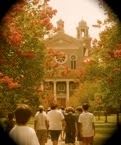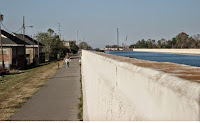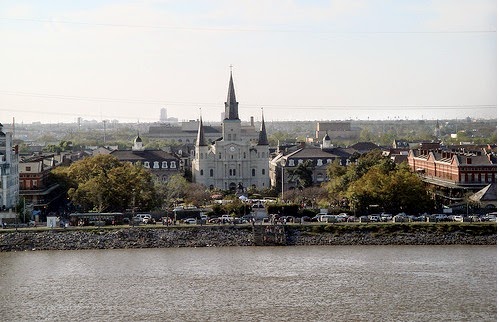We had just read Virginia Woolf’s The Mark on the Wall before the storm came. We were in a circle sharing thoughts and ideas about possessions and the seeming impermanence of things.
It was the end of the week and I had a pile of readings to get through before weekend’s end. My first semester of graduate school had only begun on Monday at Southeastern Louisiana University and I had just started a Master's program in Englis. I had paid my tuition and fees and had procured a graduate study carrel from the library so I could stash my research materials in one locked place. I had figured out the best commuter route from the house to school and I was even beginning to feel normal in my new routine even though I was a little anxious and nervous at the prospect of my next new adventure; I am planning on getting a degree in English so I can teach at our local seminary college which is run by the Benedictine religious community that I belong to as a professed monastic. We live near Covington, north of Lake Pontchartrain, the behemoth lake that separates us from the fishbowl called New Orleans and the mighty Mississip’. We call our little municipality Saint Benedict. Area code 70457. We have a little post office stuck into an extremity of the Abbey. A Romanesque Church and Bauhaus looking college are architectural
It was the end of the week and I had a pile of readings to get through before weekend’s end. My first semester of graduate school had only begun on Monday at Southeastern Louisiana University and I had just started a Master's program in Englis. I had paid my tuition and fees and had procured a graduate study carrel from the library so I could stash my research materials in one locked place. I had figured out the best commuter route from the house to school and I was even beginning to feel normal in my new routine even though I was a little anxious and nervous at the prospect of my next new adventure; I am planning on getting a degree in English so I can teach at our local seminary college which is run by the Benedictine religious community that I belong to as a professed monastic. We live near Covington, north of Lake Pontchartrain, the behemoth lake that separates us from the fishbowl called New Orleans and the mighty Mississip’. We call our little municipality Saint Benedict. Area code 70457. We have a little post office stuck into an extremity of the Abbey. A Romanesque Church and Bauhaus looking college are architectural
 |
| I lived in St. Benedict, Louisiana when the storm hit |
 |
| Hurricane Katrina is one of the most powerful storms to hit the Gulf Coast in a century |
 |
| Artificial levees (like the one above) broke — which caused catastrophic flooding in the city. |
 |
| New Orleans after the levees broke |
On the news, a little girl was crying, “Somebody help us!” A mother was pouring lukewarm water on her son’s back. A husband lost his wife; she couldn’t hold his hand, the flow of the water was too much; the storm had washed her away. Humanity is supposed to come alive when a storm hits. Even though now, Red Cross shelters and FEMA are distributing food, providing shelter, and caring for the sick and wounded, they came too late. The National Guard, the 82nd Air Borne Division, even ATF agents, are coming in to give relief, four days after the storm. Because so many people were left behind after the storm, relief shelters couldn’t provide for their needs, so people died, babies, the elderly and mental health patients. Dead bodies have been found, slumped in their wheelchairs in the Convention Center. The good news is that even though the Federal Government was slow in responding, most of the humanitarian relief has been by neighbors helping neighbors. My mother has been volunteering at the local high school which has become a local shelter. There was a story about a woman who had a baby by Caesarian section and was trying to get to Baton Rouge for care. She was in front of the Convention Center in New Orleans waiting for a bus to bring her and her baby to a hospital. Looters and thugs were firing gunshots, forcing the woman to start walking. She walked across the Crescent City Connection over the Mississippi River to a car and apparently drove to Baton Rouge. The doctor who received her at Woman’s Hospital, a refugee himself, who was just credentialed to help out, was emotional when he retold the story. Here at my house, stray folks are asking for water and food. Even showers. One family up the road who come to mass here lost their entire house and need a place to take a shower. We have people living in the library, the gym and offices scattered across campus.
I guess there is a secret desire in every one of us to weather the big storm, to see as King Lear sees: the cracked skies and the spitfire of physical evil. But this storm was different. A storm like a category five hurricane has the tendency to shake people to their basic core; either they come alive or curl into the fetal position; a storm like this one should be reassurance that we’re not dead yet! I’ve read articles about hurricane psychology and seen it in action in people, including myself. When Katrina hit, I was on the second floor of our building, watching pine tree after pine tree snap in two, sometimes like a broken toothpick and other times, trees were uprooted and splayed across our walkways, their roots gnarled and exposed to the air. I went crazy. Live Oaks kept their trunks intact but Water Oaks and Cypresses on our property were tossed like a baby’s toy. When you hear a tree, especially trees you’re familiar with, that you walk by every day, that you come to know and love, snap in two, it is a horrible noise, a sound like a crushed spine. I watched most of the storm from the second-floor balcony. As the storm barreled its way northward something inside of me, restless and unassuaged, was desperate for air. I needed to release pent up tension. So we went to the first floor to the outside walkways to see the storm at Katrina’s level, to feel the wind and rain. I was soaked and mad. We hooted and hollered at the storm. I flung out Shakespeare: crack you thunderbolts! I’m skinny, so I was afraid that the wind would take me so I hid behind Danny who is a bit heavier than I am. He didn’t appreciate it too much. The wind never picked any of us up but I have a vivid image of the Tulip Poplar crashing to its end. I was mad at God when the Tulip Poplar broke, symbolic of so much further, deeper anger. Something snaps inside of you when a big storm comes. I didn’t feel guilty that I was angry at Mother Nature; I guess can project all of my frustrations and anxiety on her.
Storms do different things to different people. Some people hunkered in their rooms and didn’t come out. Others couldn’t keep still. Like me. I was raging Shakespeare to the nymphs and dryads while the guy next to me was contemplating running through the yard to the bridge, oblivious to the fact that the wind gusts could actually pick him up and toss him to his death. One guy was already out in the storm, in the middle of the gusts, picking up window frames that had flown off. Even in the midst of the insanity, I knew I was insane, but I couldn’t stop. I had to feel the storm inside of me, the rush of it through my body like blood flow. Only then could I know for sure that it had passed. As trees fell one after another I felt sad and disoriented, as if the trees themselves were us, were me, were those that I love.
When the roof of our dining room experienced a major leak, ten or more guys got the nerve to actually fix the leak in order to save the murals that had been done to decorate our eating area. But, I think some of the Celotex panels were damaged and I came to the realization that not even art is permanent, demoralizing, but true. Watching gobs of water spray into our beautifully done murals made me realize how bad it really was.
 |
| View of St. Louis Cathedral from the Mississippi River in New Orleans |
And they didn’t. Katrina hit us in the gut, worse than Betsy and Camille in the 60’s. At first, weather reports were saying that it was good that the storm was moving westerly, supposedly saving us from an even more disastrous hit, but it seems now, judging from the destruction, that it didn’t matter. When the storm died down and we only had tropical force winds blowing, we celebrated the Eucharist in an open room. I was soaked, oddly sad and disappointed that the worst of it was over. There was something about the insanity and chaos of the storm that I loved and also hated. Receiving communion while the winds still blew, I felt my first twinge of sadness and first real conjecture of what this storm did to our way of life. It would take us days to finally realize that this wasn’t just a normal gulf hurricane. I knew it was bad, when later, while watching the news, someone commented, “oh! they only have two feet of water.” and someone else said, “they’re only walking waist-deep through the water!”
I knew New Orleans would never be the same again, maybe parts of the city uninhabitable for years; the body count will be in the ten thousand range and it will be difficult to identify all the corpses; missing person reports will go on for years and displaced persons will have to find homes and jobs elsewhere. Entire bridge networks have been washed away and people in cars stuck underneath train trestles and on the roofs of houses. Streets are only navigable in some areas by flat bottom boats where only last week cars were driving down them. I can remember in grammar school, watching historical footage from hurricane Camille’s aftermath, a storm that devastated Pass Christianne, Mississippi. A woman was with police officials and family, looking for her home that existed in a “bombed out” area where apparently everything was lost. But they found her house unscathed and I remember she was ecstatic jumping up and down in disbelief, unable to reconcile her fears with what had actually happened.
I hope stories like hers will be repeated today. New Orleans will be rebuilt, even if the politics are against it. For one: New Orleans represents a cultural heritage that fuels the national psyche. It is also home to millions of people. Louisiana is a model for other cities in the world that are suffering from coastal erosion. Louisiana produces one-third of the nation’s seafood and one-fifth of its oil and one-quarter of its natural gas. From New Orleans to Baton Rouge on the Mississippi constitute the United States’ largest port. We have 40 percent of the nation’s wetlands along our coasts and they provide wintering grounds for 70 percent of its migratory waterfowl. I got this information from the Scientific American article that I had read four years ago. If anyone says New Orleans is not worth saving, then I say they really don’t know what they’ll be missing.
I find myself saying little prayers to Our Lady of Prompt Succor, the patron of our state. Not that I have a particular devotion, but at times it is the only thing that I can utter in prayer. Slowly but surely it is dawning on me, my family, and my brothers whom I live with, the vastness of the destruction and the affect this disaster will have on our lives. I can only begin to now to painfully put all of the pieces together. My friend Bonnie was Hardy’s reddleman today (from Return of the Native), picking up sticks alongside our buildings, she represented apocalypse at bay, keeping the time with each dropped pine, a silence and calm. I am reminded of life and a quote from Woolf: "the perpetual waste and repair; all so casual, all so haphazard."

No comments:
Post a Comment
Be courteous. Speak your mind. Don’t be rude. Share.